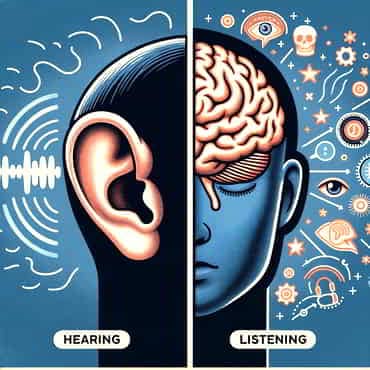How To Improve Active Listening Skills: Transform Your Relationships

Estimated reading time: 6 Min
How to improve active listening skills offers practical advice on developing and refining your skills to improve your ability to communicate.
Many years ago, during a particularly engaging personal development course, I had, several times, commented, “I hear what you say.”
At some point, the instructor paused, looked directly at me, and asked, “Are you hearing, or are you listening?”
I didn’t understand the difference at the time.
It seemed like a subtle distinction, one of those semantic nuances that didn’t hold much weight in the practical world.
However, as we explored the art of communication more deeply, the profound impact of that question became clearer.
Active listening, I learned, is far more than just hearing words; it’s an essential skill that requires full engagement and genuine responsiveness.
It’s about understanding the emotions and intentions behind the information being shared.
This skill can significantly enhance our interactions and relationships, both personally and professionally, transforming everyday conversations into meaningful connections and insightful exchanges.
How To Improve Active Listening Skills
Active listening is a communication technique that involves giving your full attention to the speaker, processing what they’re saying, and responding thoughtfully.
Unlike passive listening, where the listener might hear the words but not fully engage with the content, active listening requires active involvement in the conversation.
Here are three pillars of active listening:
- Attention
Paying attention involves being fully present in the moment and avoiding distractions. This means putting aside your thoughts and focusing entirely on the speaker. This is more like the foundation of active listening rather than a pillar. - Acknowledgement
Acknowledgment shows the speaker that you are not just hearing them but also understanding them. This can be conveyed through nods, facial expressions, and verbal affirmations like “I see” or “I understand.” - Response
A thoughtful and relevant response indicates your level of attention through active listening. This involves asking clarifying questions, reflecting back what you’ve heard, and contributing relevant information when appropriate.
By distinguishing passive listening from active listening, you can ensure you are engaged and responsive, making the conversation more productive and meaningful.
Benefits of Active Listening
Adopting active listening can have a transformative effect on all aspects of your life.
Here are some key benefits:
- Enhanced Relationships
By showing genuine interest and empathy in your conversations, active listening helps build deeper personal and professional relationships. It’s a fundamental part of building rapport. - Conflict Resolution
It plays a critical role in resolving disputes by ensuring both parties feel heard and understood, which can defuse tensions and lead to mutually agreeable solutions. - Improved Learning and Information Retention
Active listeners tend to retain information more effectively, which is particularly beneficial in educational and professional settings. - Better Decision-making
When you fully understand all aspects of a conversation, you’re more likely to make well-informed decisions.
These benefits underline why active listening is not just a communication tool but a comprehensive approach to improving interpersonal interactions and understanding.
Core Skills of Active Listening
Developing your active listening skills involves a conscious effort to engage more deeply with others when they speak.

Here are some core skills for how to improve active listening ability:
- Paying Full Attention:
- Minimise Distractions
Try to reduce background noise and interruptions. If you’re in a noisy place, suggest moving somewhere quieter or holding the conversation at a less busy time. - Non-Verbal Cues
Maintain eye contact, nod occasionally, and lean in slightly to show engagement without being intrusive.
- Minimise Distractions
- Showing That You’re Listening:
- Verbal Affirmations
Use small verbal nods such as “uh-huh” and “I see,” which don’t interrupt but show you are engaged. - Paraphrasing
Every so often, repeat back a summary of what’s been said to show understanding and to clarify points.
- Verbal Affirmations
- Providing Feedback:
- Clarifying Questions
When something isn’t clear, ask open-ended questions for clarification that encourage the speaker to expand on their thoughts. - Summarising
At the end of a discussion, summarise the main points to confirm understanding and discuss the next steps or actions to be taken.
- Clarifying Questions
Each of these skills contributes to a more robust and effective communication style, enhancing your ability to engage with others in meaningful ways.
By practicing these skills, you can turn every conversation into an opportunity for growth and connection.
Applying Active Listening in Various Scenarios
Active listening can be applied in a multitude of environments, each with its own unique challenges and opportunities.
Understanding how to adapt this skill to different settings can greatly enhance your effectiveness in each.
- In the workplace
At your place of work, active listening is invaluable. Clear communication can lead to better teamwork and quicker problem-solving. During meetings, focus entirely on the speaker without planning your response while they are talking. This can lead to more productive brainstorming sessions and fewer misunderstandings. When negotiating, listening actively can help you understand the other party’s needs and drive a more successful negotiation. - At Home
In personal relationships, active listening helps to build stronger bonds by showing care and respect for the speaker’s feelings and opinions. Practice active listening with family members by being fully present during conversations, without distractions like smartphones or television. - In Educational Settings
Students and educators can benefit from active listening by enhancing learning experiences. Teachers using active listening in their interactions with students can foster a supportive learning environment, encouraging students to engage more openly and share their ideas more freely.
Overcoming Challenges in Active Listening
While the benefits of active listening are extensive, certain challenges can impede our ability to use it effectively.
Here are some common hurdles and strategies to overcome them:
- Dealing with Complex Information
When conversations involve complex or technical information, it can be easy to lose track. To manage this, take notes to help you remember key points and ask follow-up questions to clarify uncertainties immediately. - Maintaining Focus in Long Conversations
Long discussions can test our concentration. To stay engaged, break the conversation into manageable segments, where you summarise and reflect before moving on. This helps maintain focus and keeps the conversation structured. - Handling Emotional Conversations
High emotions can disrupt active listening. When conversations get charged, focus on remaining calm and neutral. Acknowledge the speaker’s emotions with empathetic statements like, “It sounds like you feel strongly about this,” to show understanding without escalating the emotion.
Practicing Active Listening Daily
Incorporating active listening into your daily routine can gradually transform your communication style.
Here are a few practices to help cultivate this skill:
- Mindfulness Exercises
Mindfulness can enhance your ability to remain present and focused. Regular mindfulness practice, even a few minutes a day, can improve your listening skills. - Daily Listening Goals
Set a daily goal to practice a specific aspect of active listening, such as maintaining eye contact or paraphrasing. Reflect on your progress and adjust as needed. - Encourage Active Listening Among Peers
Share the concept of active listening with friends, family, and colleagues, and practice it together. This not only improves your skills but also creates a more supportive communication environment around you.
FAQs
What’s the difference between hearing and listening?
Hearing is simply the act of perceiving sound by the ear. If you are not hearing-impaired, hearing simply happens. Listening, however, is something you consciously choose to do. Listening requires concentration so that your brain processes meaning from words and sentences.
How can I tell if I’m an active listener?
Active listening involves more than just hearing someone speak. When you’re actively listening, you’ll be able to recall specific details of the conversation later and you will engage the speaker with relevant questions or comments.
Can active listening improve my relationships?
Absolutely. Active listening is a catalyst for deeper understanding and empathy, which are foundational for healthy and strong relationships.
Summary
Active listening is more than a mere communication tactic; it’s a transformative skill that can profoundly impact all areas of your life.
By consciously applying and continuously practicing the principles of active listening, you can enhance your ability to understand others, develop deeper relationships, and navigate conversations with greater success.
I encourage you to embrace these strategies, practice them diligently, and watch as your conversations—and your connections—grow richer and more rewarding.
If you have anything to add or ask, please add a comment.
😉
Richard
Suggested Resources
These resources can provide further insights into improving your active listening skills and enhancing your interpersonal communications.
- Books:
- “Just Listen” by Mark Goulston
- “The Lost Art of Listening” by Michael P. Nichols
- Online Courses:
- Coursera: “Improving Communication Skills“
- LinkedIn Learning: “Effective Listening”






